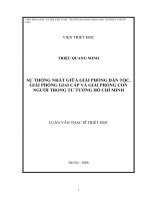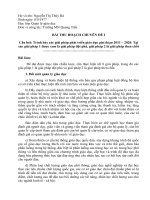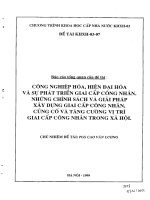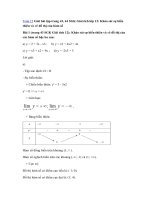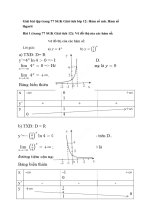20 câu ôn phần tiếng anh đánh giá năng lực đhqg tphcm phần 37 (bản word có giải)
Bạn đang xem bản rút gọn của tài liệu. Xem và tải ngay bản đầy đủ của tài liệu tại đây (125.51 KB, 11 trang )
20 câu ôn phần Tiếng Anh - Đánh giá năng lực ĐHQG TPHCM - Phần 37
(Bản word có giải)
1.2. TIẾNG ANH
Question 21-25. Choose a suitable word or phrase (marked A,B,C or D to fill in each blank)
21. I’m going to have my house___________this weekend
A. is redecorated
B. redecorated
C. will be redecorated
D. redecorate
C. about
D. on
22. She apologized to the teacher _____being late
A. to
B. for
23. The factory is said________in a fire two years ago
A. being destroyed
B. to have been destroyed
C. to have destroyed
D. to destroy
24. Either the monitor or the atheletes _____to blame for the bad result
A. be
B. are
C. is
D. to be
25. After Mary____ her degree, she intends to work in her father’s company
A. will finish
B. finishes
C. is finishing
D. will have
Question 26-30. Each of the following sentences has one error (A,B,C, or D). Find it and blacken your
choice on your answer sheet
26. Public health experts say that the money you spend to avoid is less than the cost of being sick
A. the money
B. to avoid
C. less
D. being sick
27. She has been searching something in that book all morning, but she still hasn’t found anything
A. has been searching
B. in that book
C. but
D. anything
28. Keith had so interesting and creative plans that everyone wanted to work on his committee
A. so interesting
B. plans
C. wanted
D. on
29. The grass needs cutting, so let us have one of the men to take lawn-mower and do it
A. needs
B. cutting
C. let
D. to take
30. The longer the children waited in the long queue, the more impatiently they became
A. the longer
B. waited
C. the long queue
Question 31-35. Which of the following best restates each of the given sentences?
31. “Why can’t you do your homewwork more carefully” said Henry’s boss
A. Henry’s boss criticized him for doing his job carelessly
B. Henry’s boss asked him not to do his job with care
C. Henry’s boss suggested doing the job more carefully
D. Henry’s boss warned him to do the job carefully
32. She wasn’t wearing a seat-belt. She was injured
A. If she hadn’t been wearing a seat-belt, she wouldn’t have been injured
D. impatiently
B. If she had been wearing a seat-belt, she would have been injured
C. If she had been wearing a seat-belt, she wouldn’t be injured
D. If she had been wearing a seat-belt, she wouldn’t have been injured
33. I had to clear the spare room before I could start decorating
A. Not until had I cleaned the spare room I could start decorating
B. Before I cleared the spare room I could start decorating
C. Only when I had cleaned the sapre room could I start decorating
D. Only when I had finished clearing the spare room, I could start decorating
34. He didn’t pay attention to what I said
A. He took no notice of my words
B. He didn’t hear me even though I was saying to him
C. He had no intention to talk to me
D. He took my advice
35. I should have finished my work last night but I was exhausted
A. I did finished my work last night though I was exausted
B. I was exhausted so I didn’t finish my work yesterday as planned
C. Last night I was exhausted but I tried to finish my wor
D. My work was finished last night but I was exausted
Question 36-40. Read the passage carefully
Every drop of water in the ocean, even in the deepest parts, responds to the forces that create the tides. No
other force that affects the sea is so strong. Compared with the tides, the waves created by the wind are
surface movements felt no more than a hundred fathoms below the surface. The currents also seldom
involve more than the upper several hundred fathoms despite their impressive sweep.
The tides are a response of the waters of the ocean to the pull of the Moon and the more distant Sun. In
theory, there is a gravitational attraction between the water and even the outermost star of the universe. In
reality, however, the pull of remote stars is so slight as to be obliterated by the control of the Moon and,
to a lesser extent, the Sun.
Just as the Moon rises later each day by fifty minutes, on the average, so, in most places, the time of high
tide is correspondingly later each day. And as the Moon waxes and wanes in its monthly cycle, so the
height of the tide varies. The tidal movements are strongest when the Moon is a sliver in the sky, and
when it is full. These are the highest flood tides and the lowest ebb tides of the lunar month and are called
the spring tides. At these times the Sun, Moon, and Earth are nearly in line and the pull of the two
heavenly bodies is added together to bring the water high on the beaches, to send its surf upward against
the sea cliffs, and to draw a high tide into the harbors. Twice each month, at the quarters of the Moon,
when the Sun, Moon and Earth lie at the apexes of a triangular configuration and the pull of the Sun and
Moon are opposed, the moderate tidal movements called neap tides occur. Thenthe difference between
high and low water is less than at any other time during the month
Choose an option (A, B, C or D) that best answers each question.
36. What is the main point of the first paragraph?
A. The waves created by ocean currents are very large.
B. Despite the strength of the wind, it only moves surface water.
C. Deep ocean water is seldom affected by forces that move water.
D. The tides are the most powerful force to affect the movement of ocean water.
37. The word “correspondingly” in line 10 is closest in meaning to
A. unpredictably
B. interestingly
C. similarly
D. unusually
38. What is the cause of spring tides?
A. Seasonal changes in the weather
B. The gravitational pull of the Sun and the Moon when nearly in line with the Earth
C. The Earth’s movement around the Sun
D. The triangular arrangement of the Earth, Sun, and Moon
39. According to the passage, all of the following statements about tides are true EXCEPT.
A. The time of high tide is later each day
B. Tides have a greater effect on the sea than waves do.
C. The strongest tides occur at the quarters of the Moon.
D. Neap tides are more moderate than spring tides.
40. It can be inferred from the passage that the most important factor in determining how much
gravitational effect one object in space has on the tides is __________
A. size
B. distance
C. temperature
D. density
HƯỚNG DẪN GIẢI CHI TIẾT
1.2. TIẾNG ANH
Question 21-25. Choose a suitable word or phrase (marked A,B,C or D to fill in each blank)
21. I’m going to have my house___________this weekend
A. is redecorated
B. redecorated
C. will be redecorated
D. redecorate
Phương pháp giải:
Cấu trúc bị động đặc biệt
Giải chi tiết:
Have/get sth done: nhờ ai đó làm gì (chủ ngữ của câu khơng phải là người thực hiện hành động)
Tạm dịch: Tôi định nhờ người trang trí lại nhà tuần này
22. She apologized to the teacher _____being late
A. to
B. for
C. about
D. on
Phương pháp giải:
Giới từ
Giải chi tiết:
Apologize to sb for doing/having done sth: xin lỗi ai vì điều gì
Tạm dịch: Cơ ấy xin lỗi cơ giáo vì đến muộn
23. The factory is said________in a fire two years ago
A. being destroyed
B. to have been destroyed
C. to have destroyed
D. to destroy
Phương pháp giải:
Câu gián tiếp với động từ tường thuật
Giải chi tiết:
Cấu trúc: S + is/was said + to-V/to have PII/to be Ved/ to have been PII
Two years ago => sự việc đã xảy ra trong quá khứ
The factory không phải là chủ ngữ của hành động “destroy”
=> to have been PII
Tạm dịch: Nhà máy được cho rằng là đã bị phá hủy trong một vụ cháy 2 năm trước
24. Either the monitor or the atheletes _____to blame for the bad result
A. be
B. are
C. is
D. to be
Phương pháp giải:
Sự hòa hợp chủ-vị
Giải chi tiết:
Either A or B => động từ chia theo B
Tạm dịch: Hoặc là người giám sát hoặc là các vận động viên đổ lỗi cho nhau vì kết quả khơng tốt
25. After Mary____ her degree, she intends to work in her father’s company
A. will finish
B. finishes
C. is finishing
D. will have
Phương pháp giải:
Thì của động từ
Giải chi tiết:
Khơng dùng thì tương lai đơn trong các mệnh đề chỉ thời gian trong tương lai
Tạm dịch: Sau khi Mary có bằng, cơ ấy định àm việc cho công ty của bố
Question 26-30. Each of the following sentences has one error (A,B,C, or D). Find it and blacken your
choice on your answer sheet
26. Public health experts say that the money you spend to avoid is less than the cost of being sick
A. the money
B. to avoid
C. less
D. being sick
Phương pháp giải:
Dạng của động từ
Giải chi tiết:
Sau “spend” động từ ở dạng “Ving”
Sửa: to avoid => avoiding
Tạm dịch: Các chuyên gia sức khoẻ cộng đồng cho biết, số tiền một người dành ra để phòng bệnh ít hơn
so với chi phí chữa bệnh.
27. She has been searching something in that book all morning, but she still hasn’t found anything
A. has been searching
B. in that book
C. but
D. anything
Phương pháp giải:
Giới từ
Giải chi tiết:
Search for sth: tìm kiếm cái gì
Tạm dịch: Cơ ấy tìm cái gì đó trong sách cả sáng nhưng cô ấy không phát hiện ra điều gì
28. Keith had so interesting and creative plans that everyone wanted to work on his committee
A. so interesting
B. plans
C. wanted
D. on
Phương pháp giải:
Cấu trúc “so/such”
Giải chi tiết:
So + adj/adv
Such + Noun phrase
Sửa: so => such
Tạm dịch: Keith có những kế hoạch thú vị và sáng tạo đến nỗi mọi người đều muốn làm việc trong ủy
ban của anh ấy
29. The grass needs cutting, so let us have one of the men to take lawn-mower and do it
A. needs
B. cutting
C. let
D. to take
Phương pháp giải:
Cấu trúc nhờ vả
Giải chi tiết:
Dạng bị động: have/get sth done
Dạng chủ động: have sb do sth // get sb to do sth
Tạm dịch: Cỏ cần cắt, vì vậy hãy để một trong những người đàn ông nhận máy cắt cỏ và làm việc đó
30. The longer the children waited in the long queue, the more impatiently they became
A. the longer
B. waited
C. the long queue
D. impatiently
Phương pháp giải:
Từ loại
Giải chi tiết:
Bổ nghĩa cho động từ liên kết (become, get, seem, appear….) là tính từ
Sửa: impatiently (adv) => impatient (adj)
Tạm dịch: Những đứa trẻ xếp hàng dài chờ đợi càng lâu, chúng càng trở nên sốt ruột hơn
Question 31-35. Which of the following best restates each of the given sentences?
31. “Why can’t you do your homewwork more carefully” said Henry’s boss
A. Henry’s boss criticized him for doing his job carelessly
B. Henry’s boss asked him not to do his job with care
C. Henry’s boss suggested doing the job more carefully
D. Henry’s boss warned him to do the job carefully
Phương pháp giải:
Câu gián tiếp
Giải chi tiết:
“why can’t you do..carefully” => mang hàm ý chỉ trích
=> criticize sb for doing/having done sth: chỉ trích ai vì đã làm gì
Warn sb to do sth: cảnh báo ai khi làm gì
Suggest doing sth: gợi ý ai làm gì
Ask sb do sth: yêu cầu ai làm gì
Tạm dịch:
“Tại sao bạn khơng thể làm bài tập ở nhà cẩn thận hơn”, ơng chủ của Henry nói
A. Sếp của Henry đã chỉ trích anh ta vì đã làm cơng việc của mình một cách cẩu thả
B. Sếp của Henry yêu cầu anh ta không làm công việc của mình một cách cẩn thận
Sếp của C. Henry đề nghị thực hiện công việc cẩn thận hơn
D. Sếp của Henry đã cảnh báo anh ta phải làm công việc một cách cẩn thận
32. She wasn’t wearing a seat-belt. She was injured
A. If she hadn’t been wearing a seat-belt, she wouldn’t have been injured
B. If she had been wearing a seat-belt, she would have been injured
C. If she had been wearing a seat-belt, she wouldn’t be injured
D. If she had been wearing a seat-belt, she wouldn’t have been injured
Phương pháp giải:
Câu điều kiện loại 3
Giải chi tiết:
Dùng câu điều kiện loại 3 để đưa ra giả thiết trái ngược quá khứ
Thực tế là cô ta bị thương vì đã khơng thắt dây an toan => câu điều kiện loại 3 sẽ thành: Nếu như cô ta
thắt dây an tồn, cơ ta đã khơng bị thương
Cấu trúc: S + had + Ved/V3 [ had been Ving] , S + would/might/could + have + Ved/V3
Tạm dịch: Nếu như cơ ta thắt dây an tồn, cơ ta đã không bị thương
33. I had to clear the spare room before I could start decorating
A. Not until had I cleaned the spare room I could start decorating
B. Before I cleared the spare room I could start decorating
C. Only when I had cleaned the sapre room could I start decorating
D. Only when I had finished clearing the spare room, I could start decorating
Phương pháp giải:
Đảo ngữ “only when”
Giải chi tiết:
Dịch nghĩa: Tơi phải dọn phịng trống trước khi tơi có thể bắt đầu trang trí nó.
= C. Chỉ khi nào tơi dọn sạch căn phịng trống, tơi mới có thể bắt đầu trang trí.
Cấu trúc đảo ngữ với Only when: Only when + clause, Auxiliary verb + S + V: Chỉ đến khi. => Đáp án D
sai vì khơng đảo ngữ.
Cấu trúc đảo ngữ với Not until: Not until + clause/ Adv of time + Auxiliary + S + V => Đáp án A sai vì
đảo ngữ ở mệnh đề sau Not until
Đáp án B. Trước khi tơi dọn phịng trống, tơi có thể bắt đầu trang trí. => Khơng đúng với nghĩa của câu
gốc
34. He didn’t pay attention to what I said
A. He took no notice of my words
B. He didn’t hear me even though I was saying to him
C. He had no intention to talk to me
D. He took my advice
Phương pháp giải:
Câu đồng nghĩa
Giải chi tiết:
Not pay attention to sth = took no notice of sth
Tạm dịch:
Anh ấy khơng chú ý đến những gì tơi nói
A. Anh ấy khơng để ý đến lời nói của tôi
B. Anh ấy không nghe thấy tôi mặc dù tôi đang nói với anh ấy
C. Anh ấy khơng có ý định nói chuyện với tơi
D. Anh ấy đã nghe theo lời khuyên của tôi
35. I should have finished my work last night but I was exhausted
A. I did finished my work last night though I was exausted
B. I was exhausted so I didn’t finish my work yesterday as planned
C. Last night I was exhausted but I tried to finish my wor
D. My work was finished last night but I was exausted
Phương pháp giải:
Động từ khuyết thiếu
Giải chi tiết:
Should have done sth: đáng nhẽ nên làm gì nhưng khơng làm
=> Câu đề bài ám chỉ thực tế người nói khơng hồn thành hồn cơng việc vì mệt
Tạm dịch:
A. Tơi đã hồn thành cơng việc của mình tối qua mặc dù tơi đã rất mệt mỏi => sai nghĩa
B. Tôi đã kiệt sức vì vậy tơi đã khơng hồn thành cơng việc của mình ngày hơm qua như kế hoạch => phù
hợp
C. Đêm qua tôi đã kiệt sức nhưng tôi đã cố gắng hồn thành việc học của mình => sai nghĩa
D. Cơng việc của tơi đã hồn thành vào tối qua nhưng tôi đã quá mệt mỏi => sai nghĩa
Question 36-40. Read the passage carefully
Every drop of water in the ocean, even in the deepest parts, responds to the forces that create the tides. No
other force that affects the sea is so strong. Compared with the tides, the waves created by the wind are
surface movements felt no more than a hundred fathoms below the surface. The currents also seldom
involve more than the upper several hundred fathoms despite their impressive sweep.
The tides are a response of the waters of the ocean to the pull of the Moon and the more distant Sun. In
theory, there is a gravitational attraction between the water and even the outermost star of the universe. In
reality, however, the pull of remote stars is so slight as to be obliterated by the control of the Moon and,
to a lesser extent, the Sun.
Just as the Moon rises later each day by fifty minutes, on the average, so, in most places, the time of high
tide is correspondingly later each day. And as the Moon waxes and wanes in its monthly cycle, so the
height of the tide varies. The tidal movements are strongest when the Moon is a sliver in the sky, and
when it is full. These are the highest flood tides and the lowest ebb tides of the lunar month and are called
the spring tides. At these times the Sun, Moon, and Earth are nearly in line and the pull of the two
heavenly bodies is added together to bring the water high on the beaches, to send its surf upward against
the sea cliffs, and to draw a high tide into the harbors. Twice each month, at the quarters of the Moon,
when the Sun, Moon and Earth lie at the apexes of a triangular configuration and the pull of the Sun and
Moon are opposed, the moderate tidal movements called neap tides occur. Thenthe difference between
high and low water is less than at any other time during the month
Choose an option (A, B, C or D) that best answers each question.
36. What is the main point of the first paragraph?
A. The waves created by ocean currents are very large.
B. Despite the strength of the wind, it only moves surface water.
C. Deep ocean water is seldom affected by forces that move water.
D. The tides are the most powerful force to affect the movement of ocean water.
Phương pháp giải:
Đọc hiểu ý chính
Giải chi tiết:
Điểm chính của đoạn đầu tiên là gì?
A. Sóng do dịng biển tạo ra rất lớn.
B. Mặc dù sức mạnh của gió, nó chỉ di chuyển nước trên bề mặt.
C. Nước sâu ít khi chịu tác dụng của các lực làm nước di chuyển.
D. Thủy triều là lực tác động mạnh nhất đến sự chuyển động của nước đại dương.
Thông tin: "Every drop of water in the ocean, even in the deepest parts, responds to the forces that create
the
tides. No other force that affects the sea is so strong.
Tạm dịch: Mỗi giọt nước trong đại dương, ngay cả ở những phần sâu nhất, đều phản ứng lại các lực tạo
ra
thủy triều. Khơng có lực lượng nào khác tác động đến biển mạnh như vậy.
37. The word “correspondingly” in line 10 is closest in meaning to
A. unpredictably
B. interestingly
C. similarly
D. unusually
Phương pháp giải:
Từ vựng
Giải chi tiết:
Từ “felt” ở đoạn 3 gần nghĩa nhất với_____
A. unpredictably: không dự đốn được
B. interestingly: khơng thú vị
C. similarly: tương tự
D. unusually: bất thường
Thông tin: Just as the Moon rises later each day by fifty minutes, on the average, so, in most places, the
time of high tide is correspondingly later each day.
Tạm dịch: Cũng giống như Mặt trăng mọc muộn hơn trung bình mỗi ngày 50 phút, vì vậy, ở hầu hết các
nơi, thời gian thủy triều dâng cao tương ứng muộn hơn mỗi ngày.
38. What is the cause of spring tides?
A. Seasonal changes in the weather
B. The gravitational pull of the Sun and the Moon when nearly in line with the Earth
C. The Earth’s movement around the Sun
D. The triangular arrangement of the Earth, Sun, and Moon
Phương pháp giải:
Đọc hiểu chi tiết
Giải chi tiết:
Nguyên nhân của thủy triều là gì?
A. Sự thay đổi theo mùa của thời tiết
B. Lực hút của Mặt trời và Mặt trăng khi gần thẳng hàng với Trái đất
C. Chuyển động của Trái đất quanh Mặt trời
D. Sự sắp xếp hình tam giác của Trái đất, Mặt trời và Mặt trăng
Thông tin: the lowest ebb tides of the lunar month and are called the spring tides. At these times the Sun,
Moon, and Earth are nearly in line and the pull of the two heavenly bodies is added together to bring the
water
high on the beaches, to send its surf upward against the sea cliffs, and to draw a high tide into the harbors.
Tạm dịch: thủy triều xuống thấp nhất của tháng âm lịch và được gọi là thủy triều mùa xuân. Vào những
thời điểm này, Mặt trời, Mặt trăng và Trái đất gần như thẳng hàng và lực kéo của hai thiên thể được cộng
lại với nhau để mang lại nước cao trên các bãi biển, để lướt sóng của nó lên trên các vách đá biển và để
kéo thủy triều lên các bến cảng
39. According to the passage, all of the following statements about tides are true EXCEPT.
A. The time of high tide is later each day
B. Tides have a greater effect on the sea than waves do.
C. The strongest tides occur at the quarters of the Moon.
D. Neap tides are more moderate than spring tides.
Phương pháp giải:
Đọc hiểu chi tiết
Giải chi tiết:
Theo đoạn văn, tất cả các câu sau đây về thủy triều đều đúng NGOẠI TRỪ:
A. Thời gian triều cường muộn hơn mỗi ngày
B. Thủy triều ảnh hưởng đến biển nhiều hơn sóng.
C. Thủy triều mạnh nhất xảy ra ở các phần tư của Mặt trăng.
D. Thủy triều gần ôn hòa hơn thủy triều vào mùa xuân.
40. It can be inferred from the passage that the most important factor in determining how much
gravitational effect one object in space has on the tides is __________
A. size
Phương pháp giải:
Đọc hiểu suy luận
B. distance
C. temperature
D. density
Giải chi tiết:
Từ đoạn văn có thể suy ra rằng yếu tố quan trọng nhất trong việc xác định tác dụng hấp dẫn của một vật
thể trong không gian lên thủy triều là __________
A. kích thước B. khoảng cách C. nhiệt độ D. mật độ
Thông tin: The tides are a response of the waters of the ocean to the pull of the Moon and the more
distant
Sun. "
Tạm dịch: Thủy triều là phản ứng của nước đại dương với lực kéo của Mặt trăng và càng xa
Mặt trời. "
Chú ý khi giải:
Nội dung dịch:
Mỗi giọt nước trong đại dương, ngay cả ở những phần sâu nhất, đều phản ứng lại các lực tạo ra thủy triều.
Khơng có lực lượng nào khác tác động đến biển mạnh như vậy. So với thủy triều, sóng do gió tạo ra là
những chuyển động trên bề mặt được cảm nhận dưới bề mặt không quá một trăm phương án. Các dòng
chảy cũng hiếm khi liên quan đến nhiều hơn vài trăm mệnh lệnh trên mặc dù độ quét của chúng rất ấn
tượng.
Thủy triều là phản ứng của nước trong đại dương với lực kéo của Mặt trăng và Mặt trời ở xa hơn. Về lý
thuyết, có một lực hấp dẫn giữa nước và thậm chí cả ngơi sao ngồi cùng của vũ trụ. Tuy nhiên, trên thực
tế, lực kéo của các ngôi sao ở xa đến mức bị xóa sổ bởi sự kiểm sốt của Mặt trăng và ở một mức độ thấp
hơn là Mặt trời.
Cũng giống như Mặt trăng mọc muộn hơn trung bình mỗi ngày 50 phút, vì vậy, ở hầu hết các nơi, thời
gian thủy triều dâng cao tương ứng muộn hơn mỗi ngày. Và khi Mặt trăng sáp và suy yếu theo chu kỳ
hàng tháng, do đó độ cao của thủy triều thay đổi. Các chuyển động của thủy triều mạnh nhất khi Mặt
trăng là một mảnh trên bầu trời và khi nó đầy đặn. Đây là những lần triều cường cao nhất và triều xuống
thấp nhất trong tháng âm lịch và được gọi là thủy triều mùa xuân. Vào những thời điểm này, Mặt trời,
Mặt trăng và Trái đất gần thẳng hàng và lực kéo của hai thiên thể được cộng lại với nhau để đưa nước lên
cao trên các bãi biển, đẩy sóng của nó lên trên các vách đá biển và kéo thủy triều lên. vào bến cảng. Hai
lần mỗi tháng, tại các phần tư của Mặt trăng, khi Mặt trời, Mặt trăng và Trái đất nằm ở đỉnh của một hình
tam giác và lực kéo của Mặt trời và Mặt trăng đối nghịch nhau, các chuyển động thủy triều vừa phải được
gọi là thủy triều gần xảy ra. Chênh lệch giữa mực nước cao và nước thấp hơn bất kỳ thời điểm nào khác
trong tháng
